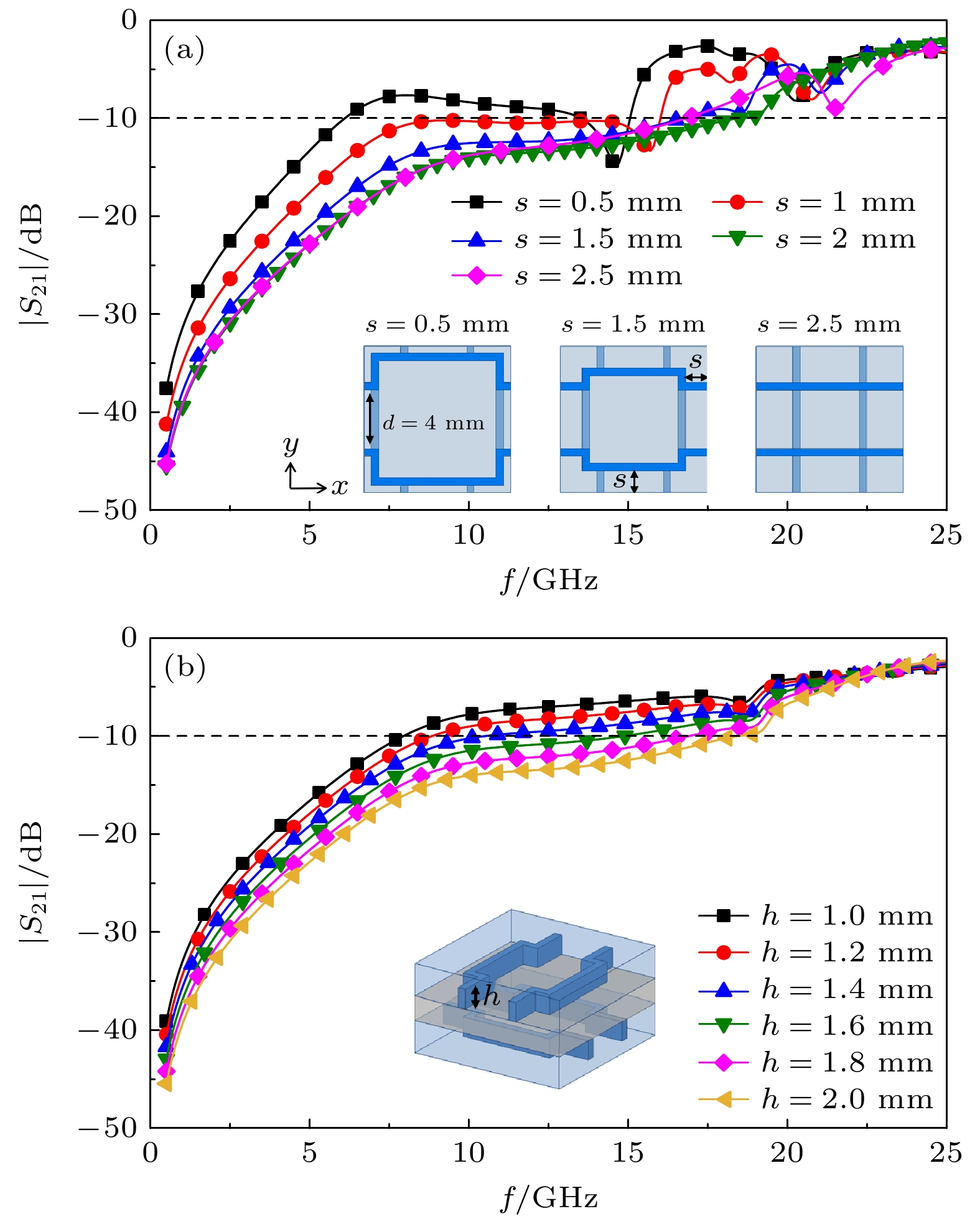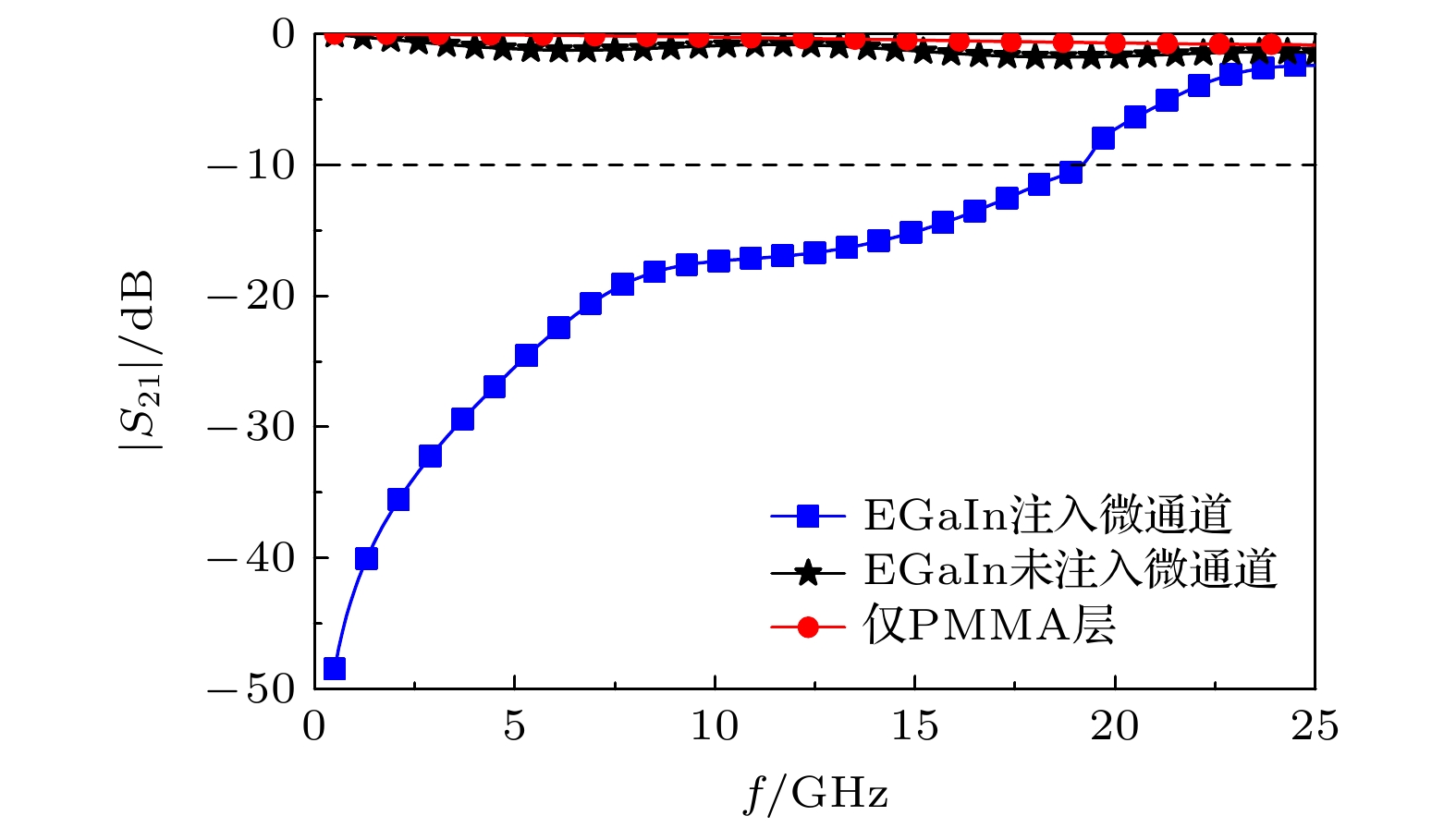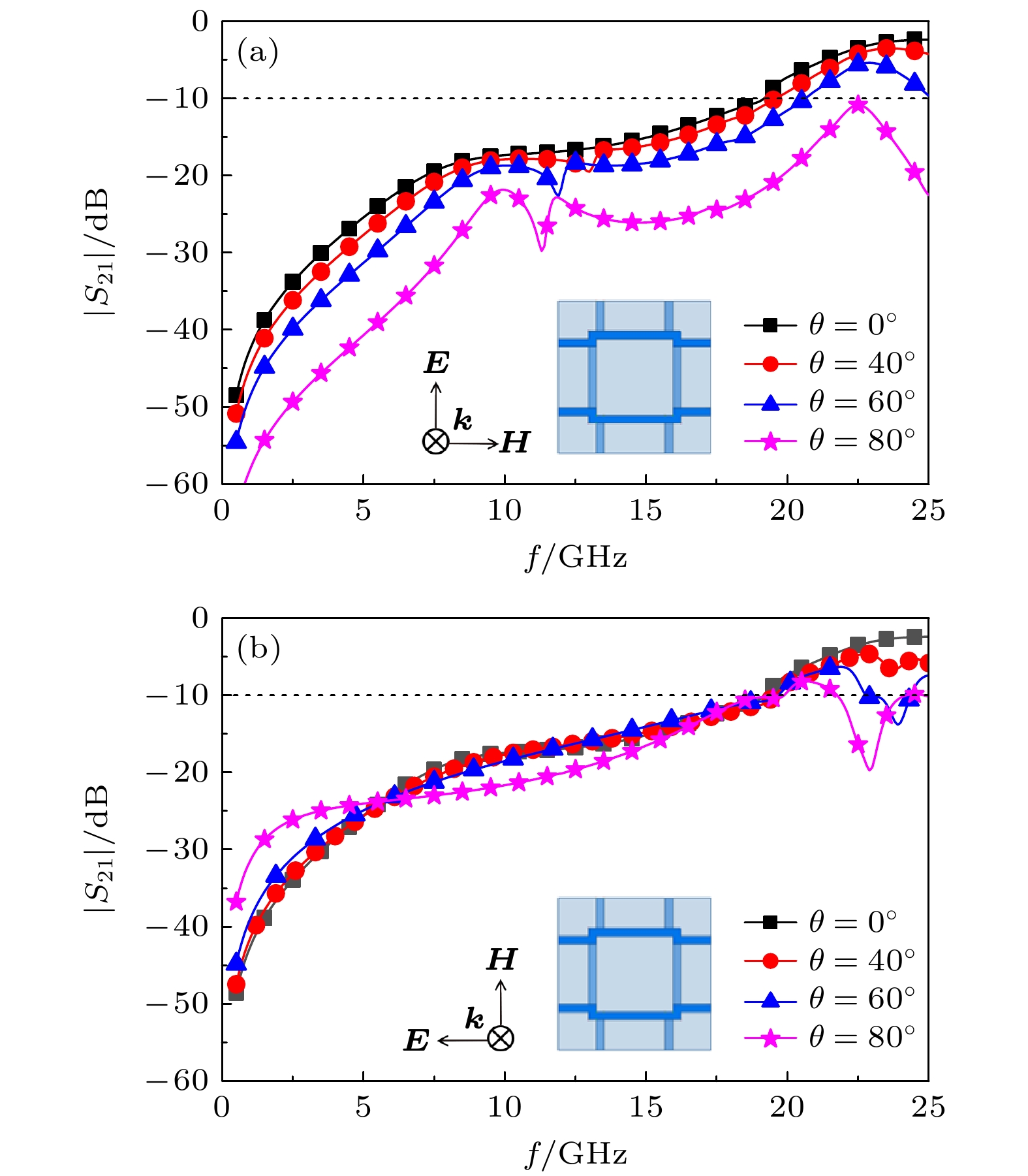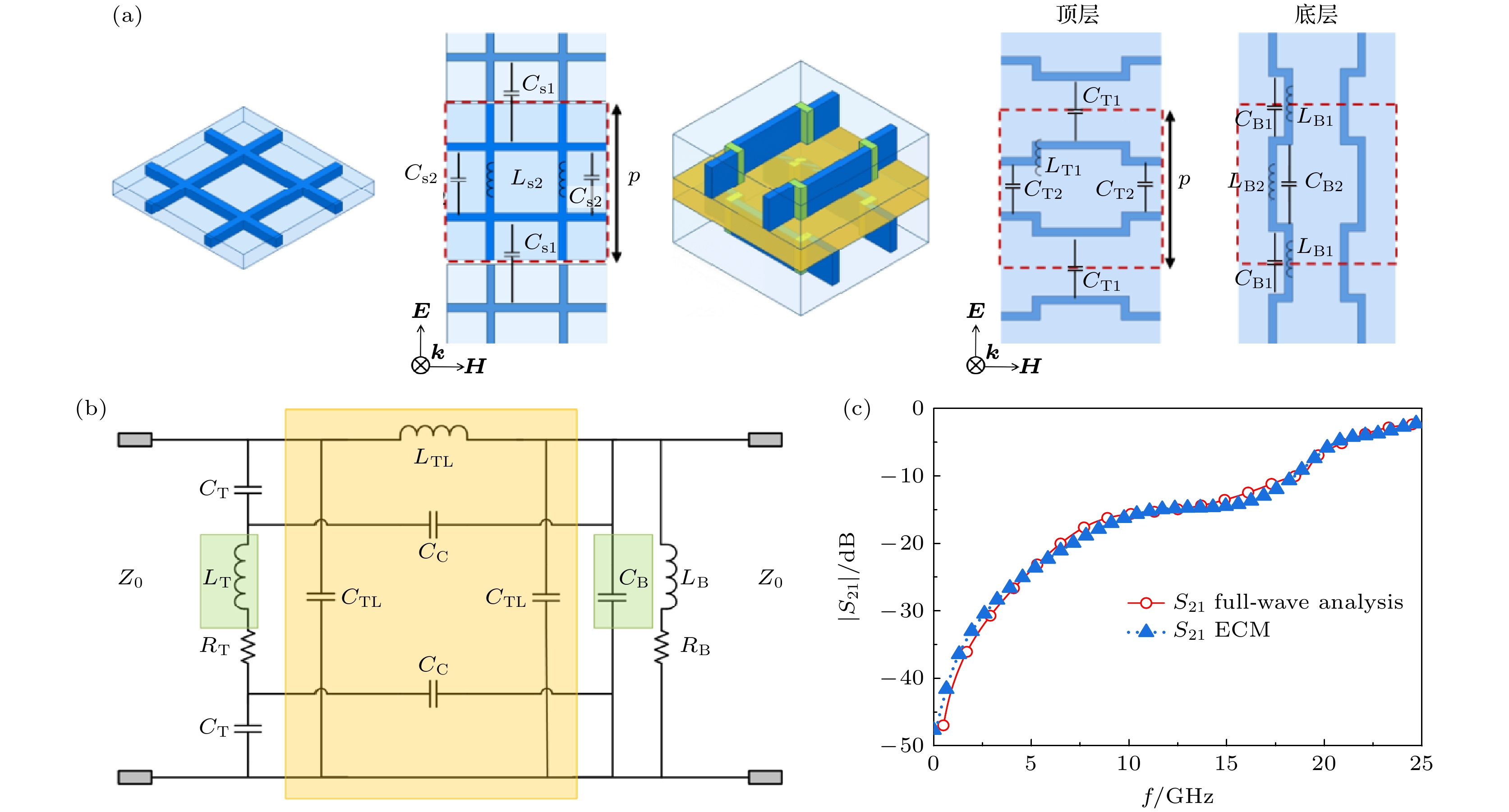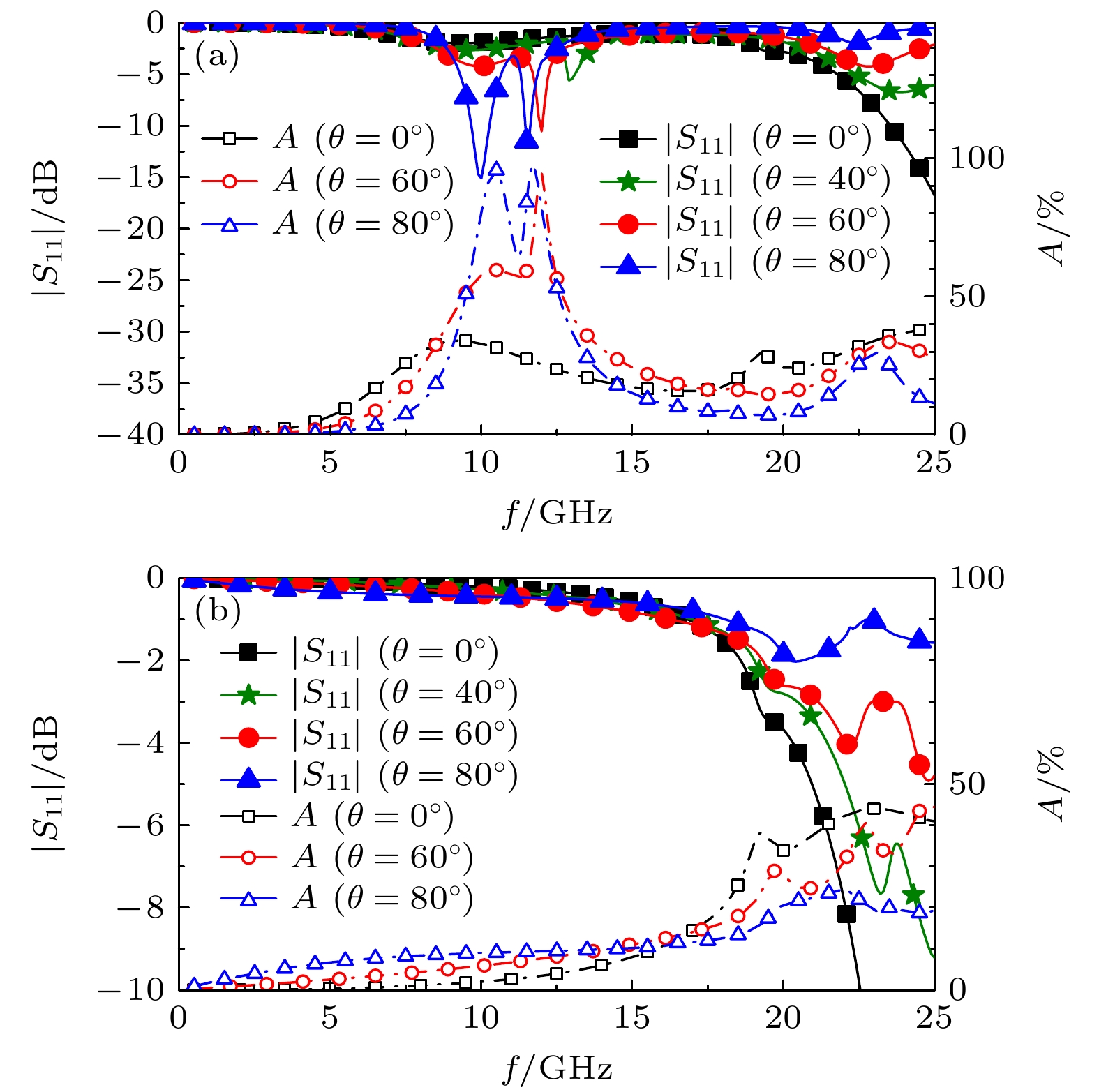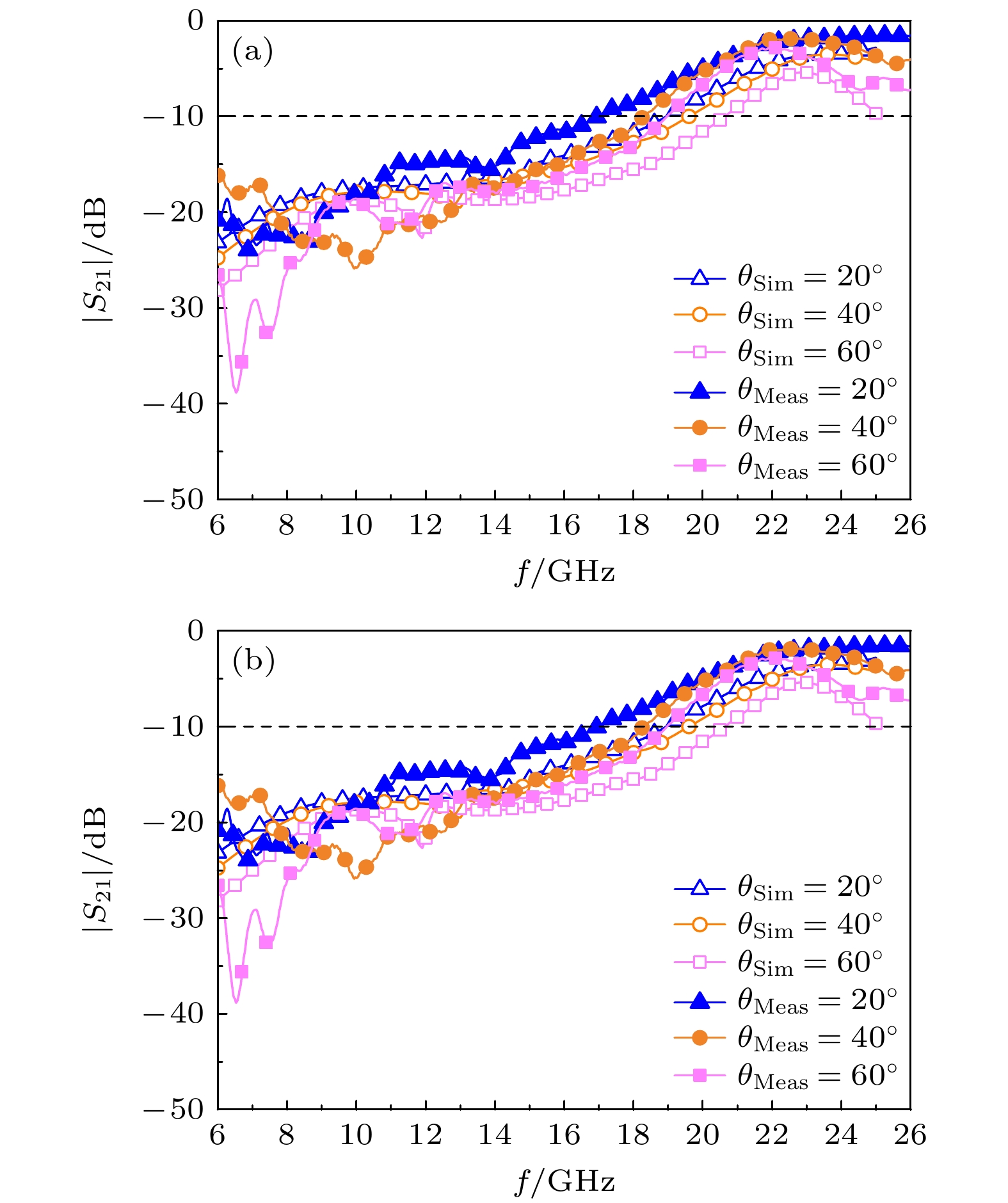-
高频电磁波主要通过玻璃门窗进入建筑物内部, 设计具有光学透明且屏蔽功能可开关的超宽带电磁屏蔽体, 对同时需要电磁安全和采光的特定场所具有重要工程应用价值. 本文利用液态金属的流动性, 提出了一种透明可开关电磁屏蔽体的设计新思路. 利用液态金属流动性作为电磁屏蔽的切换开关, 利用其导电性及Ω型频率选择表面(FSS)结构设计实现超宽带电磁屏蔽. 该FSS结构由三层透明材料构成, 中间层为聚甲基丙烯酸甲酯(PMMA), 顶层和底层为聚二甲基硅氧烷(PDMS), 且其中嵌有正交排列的Ω型微通道. 通过对微通道中注入液态金属, 可将该FSS结构的频率响应从全通状态切换到带阻状态. 双层Ω型微通道设计可增强液态金属的流动性并减半其用量, 同时实现18.1 GHz以下(覆盖P, L, S, C, X和Ku波段)超宽带电磁干扰抑制, 且具有高达80°的极化角度稳定性. 所设计的FSS电磁屏蔽结构单元81%的面积未覆盖金属, 可获得良好的光学透明性. 通过仿真计算TE和TM两种极化方式下的反射系数和吸收率, 深入分析了所设计结构的超宽阻带和高角度稳定性机理. 对所设计结构进行制备和实验测试, 测试结果与仿真结果基本吻合, 验证了所设计FSS结构的超宽带电磁屏蔽性能.In view of the fact that high-frequency electromagnetic waves mainly enter buildings through windows and glass doors, switchable optically-transparent shielding with broad stopband is increasingly needed. Herein, a novel design for a switchable and optically transparent frequency selective surface (FSS) with ultrawide-stopband is presented in this study. The structure consists of a polymethyl methacrylate (PMMA) layer sandwiched between polydimethylsiloxane (PDMS) layers which contain liquid metal microchannels arranged in an orthogonal Ω-shaped configuration. The mobility of the liquid metal can switch the FSS response from an all-pass to an ultrawide bandstop behavior. The proposed FSS achieves a rejection bandwidth of 18.1 GHz, covering P, L, S, C, X and Ku bands, while maintaining a transparency of 81% and high angular stability up to 80°, regardless of polarization. Furthermore, the mechanism behind the ultrawide stopband and high angular stability is explored through an analysis of reflection and absorption for both TE polarization and TM polarization. Experimental validation under both normal and oblique incidence demonstrates the ultrawide-stopband performance of the fabricated FSS.
-
Keywords:
- electromagnetic shielding /
- frequency selective surface /
- liquid metal /
- optically transparent /
- switchable
[1] Munk B A, 2000 Frequency Selective Surfaces: Theory and Design (New York, USA: Wiley) p63
[2] 王东俊, 孙子涵, 张袁, 唐莉, 闫丽萍 2024 物理学报 73 024201
 Google Scholar
Google Scholar
Wang D J, Sun Z H, Zhang Y, Tang L, Yan L P 2024 Acta Phys. Sin. 73 024201
 Google Scholar
Google Scholar
[3] 赵宇婷, 李迎松, 杨国辉 2020 物理学报 69 198101
 Google Scholar
Google Scholar
Zhao Y T, Li Y S, Yang G H 2020 Acta Phys. Sin. 69 198101
 Google Scholar
Google Scholar
[4] Liao W J, Zhang W Y, Hou Y C, Chen S T, Kuo C Y, Chou M 2019 IEEE Antennas Wirel. Propag. Lett. 18 2076
 Google Scholar
Google Scholar
[5] 冯奎胜, 李娜, 李桐 2022 物理学报 71 034101
 Google Scholar
Google Scholar
Feng K S, Li N, Li T 2022 Acta Phys. Sin. 71 034101
 Google Scholar
Google Scholar
[6] Chiu C N, Chang Y C, Hsieh H C, Chen C H 2010 IEEE Trans. Electromagn. Compat. 52 56
 Google Scholar
Google Scholar
[7] Li D, Li T W, Li E P, Zhang Y J 2018 IEEE Trans. Electromagn. Compat. 60 768
 Google Scholar
Google Scholar
[8] Nauman M, Saleem R, Rashid A K, Shafique M F 2016 IEEE Trans. Electromagn. Compat. 58 419
 Google Scholar
Google Scholar
[9] Yin W Y, Zhang H, Zhong T, Min X L 2018 IEEE Trans. Electromagn. Compat. 60 2057
 Google Scholar
Google Scholar
[10] Chaluvadi M, Kanth V K, Thomas K G 2020 IEEE Trans. Electromagn. Compat. 62 1068
 Google Scholar
Google Scholar
[11] Yong W Y, Rahim S K A, Himdi M, Seman F C, Suong D L, Ramli M R, Elmobarak H A 2018 IEEE Access 6 11657
 Google Scholar
Google Scholar
[12] Chaudhary V, Panwar R 2021 IEEE Trans. Magn. 57 2800710
 Google Scholar
Google Scholar
[13] Abirami B S, Sundarsingh E F, Ramalingam V S 2020 IEEE Trans. Electromagn. Compat. 62 2643
 Google Scholar
Google Scholar
[14] Sanjeev Y, Prakash J C , Mohan S M 2019 IEEE Trans. Electromagn. Compat. 61 887
 Google Scholar
Google Scholar
[15] Yang Y, Li W, Salama K N, Shamim A 2021 IEEE Trans. Antennas Propag. 69 2779
 Google Scholar
Google Scholar
[16] Lei Q Y, Luo Z L, Zheng X Y, Lu N, Zhang Y M, Huang J F, Yang L, Gao S M, Liang Y Y, He S L 2023 Opt. Mater. Express 13 469
 Google Scholar
Google Scholar
[17] Guo Q X, Peng Q Y, Qu M J, Su J X, Li Z R 2022 Opt. Express 30 7793
 Google Scholar
Google Scholar
[18] Zhang Y Q, Dong H X, Mou N L, Chen L L, Li R H, Zhang L 2020 Opt. Express 28 26836
 Google Scholar
Google Scholar
[19] Jiang H, Yang W, Lei S W, Hu H Q, Chen B, Bao Y F, He Z Y 2021 Opt. Express 29 29439
 Google Scholar
Google Scholar
[20] Dewani A A, O’Keefe S G, Thiel D V, Galehdar A 2018 IEEE Trans. Antennas Propag. 66 790
 Google Scholar
Google Scholar
[21] Habib S, Kiani G I, Butt M F U 2019 IEEE Access 7 65075
 Google Scholar
Google Scholar
[22] Xu S J, Li Y, Ahmed M, Fang L D, Jin N, Li B H, Huo S Y, Lei X Y, Sun Z, Yu H Y, Li E P 2021 IEEE Access 9 161854
 Google Scholar
Google Scholar
[23] Syed I S, Ranga Y, Matekovits L, Esselle K P, Hay S 2014 IEEE Trans. Electromagn. Compat. 56 1404
 Google Scholar
Google Scholar
[24] Katoch K, Jaglan N, Gupta S D 2021 IEEE Trans. Electromagn. Compat. 63 1423
 Google Scholar
Google Scholar
[25] Li P, Liu W, Ren Z, Meng W, Song L 2022 IEEE Access 10 9446
 Google Scholar
Google Scholar
[26] 周仕浩, 房欣宇, 李猛猛, 俞叶峰, 陈如山 2020 物理学报 69 204101
 Google Scholar
Google Scholar
Zhou S H, Fang X Y, Li M M, Yu Y F, Chen R S 2020 Acta Phys. Sin. 69 204101
 Google Scholar
Google Scholar
[27] Lei B J, Zamora A, Chun T F, Ohta A T, Shiroma W A. 2011 IEEE Microw. Wirel. Compon. Lett. 21 465
 Google Scholar
Google Scholar
[28] Ghosh S, Srivastava K V 2018 IEEE Trans. Electromagn. Compat. 60 166
 Google Scholar
Google Scholar
[29] Saikia M, Srivastava K V, Ramakrishna S A 2020 IEEE Trans. Antennas Propag. 68 2937
 Google Scholar
Google Scholar
[30] Sivasamy R, Moorthy B, Kanagasabai M, Samsingh V R, Alsath M G N 2018 IEEE Trans. Electromagn. Compat. 60 280
 Google Scholar
Google Scholar
[31] 韩鹏, 王军, 王甲富, 等 2016 物理学报 65 197701
 Google Scholar
Google Scholar
Han P, Wang J, Wang J F, et al. 2016 Acta Phys. Sin. 65 197701
 Google Scholar
Google Scholar
[32] Ghosh S, Lim S 2018 IEEE Trans. Antennas Propag. 66 4953
 Google Scholar
Google Scholar
[33] Wang C R, Yan L P, Sun Z H, Yang Y, Zhao X 2022 Asia-Pacific International Symposium on Electromagnetic Compatibility (APEMC), Beijing, China, September 1–4, 2022 p669
[34] Sheikh S 2016 IEEE Antennas Wirel. Propag. Lett. 15 1661
 Google Scholar
Google Scholar
[35] Ghosh S, Lim S 2018 IEEE Trans. Microw. Theory Tech. 66 3857
 Google Scholar
Google Scholar
[36] Yan L P, Xu L L, Gao R X K, Zhang J H, Yang X P, Zhao X 2022 IEEE Trans. Electromagn. Compat. 64 251
 Google Scholar
Google Scholar
-
图 5 (a)单层网格结构与文中FSS结构的ECM分析; (b)文中FSS的ECM; (c) ECM与全波分析传输系数比较
Fig. 5. (a) Equivalent circuit model (ECM) analysis of the single layer grid structure and the proposed three-layer FSS structure; (b) summarized ECM of the proposed FSS; (c) comparison of transmission coefficient between ECM and full-wave analysis.
图 8 制造过程概览 (a) 金属模具; (b) PDMS混合物; (c)将溶液倒入模具; (d) 脱模; (e) 向微通道注入液态金属(EGaIn); (f) 透过FSS结构看到的美丽风景
Fig. 8. Overview of the fabrication process: (a) Metal mold; (b) the PDMS mixture; (c) pull the solution into the mold; (d) demold; (e) inject liquid metal (EGaIn) into the microchannel; (f) beautiful scenery seen through the proposed FSS.
表 1 FSS单元结构所含材料的电磁特性参数
Table 1. Electromagnetic characteristics of the materials contained in the FSS unit.
电磁特性参数 材料名 值 相对介电常数 PDMS 3 – j0.195 PMMA 2.55 – j0.0051 EGaIn 1 相对磁导率 PDMS 1 PMMA 1 EGaIn 1 电导率/(S·m–1) EGaIn 3.4 × 106 表 2 FSS单元结构参数
Table 2. Value of parameters in the unit cell.
参量 d s w h hPDMS hPMMA p 值/mm 4 2 0.5 2 2.7 1.5 10 表 3 TE极化参数值
Table 3. Parameters value for TE polarization.
入射角
/(°)频率/GHz S11/dB S21/dB Zin/Ω Z0/Ω Re Im 80 10.5 –15.51 –18.23 2848.8 –565.8 2171.1 80 11.7 –20.79 –18.95 1844.8 –119.0 2171.1 60 12 –14.9 –17.01 765.1 –290.3 754 表 4 与文献中相关工作的 FSS结构性能对比
Table 4. Performance comparison of our design with what of reported FSSs.
文献 透明度/% 可开关或可调谐性能 10 dB 屏蔽带宽/GHz 角度稳定性/(°) [21] N N 3.0—12.0 60 [22] N N 7.34—15.0 45 [15] 81.6 N 0.71—1.25
1.73—2.1660 [16] 84.5 N 8.0—12.0 NM [27] N 汞和油的体积调谐 4.08—16.96 NM [28] N 变容二极管调谐 0.54—2.5 60 [25] N EGaIn注入不同层调谐 <4.5 (底层结构)
< 12.2 (顶层结构)NM [32] N EGaIn注入控制全通到带阻 1.9—3.1 (TM 极化)
3.2—4.2 (TE极化)45
60本文设计 81 EGaIn注入控制全通到阻带 < 18.1 80 注: N表示不支持该功能; NM表示未提及 -
[1] Munk B A, 2000 Frequency Selective Surfaces: Theory and Design (New York, USA: Wiley) p63
[2] 王东俊, 孙子涵, 张袁, 唐莉, 闫丽萍 2024 物理学报 73 024201
 Google Scholar
Google Scholar
Wang D J, Sun Z H, Zhang Y, Tang L, Yan L P 2024 Acta Phys. Sin. 73 024201
 Google Scholar
Google Scholar
[3] 赵宇婷, 李迎松, 杨国辉 2020 物理学报 69 198101
 Google Scholar
Google Scholar
Zhao Y T, Li Y S, Yang G H 2020 Acta Phys. Sin. 69 198101
 Google Scholar
Google Scholar
[4] Liao W J, Zhang W Y, Hou Y C, Chen S T, Kuo C Y, Chou M 2019 IEEE Antennas Wirel. Propag. Lett. 18 2076
 Google Scholar
Google Scholar
[5] 冯奎胜, 李娜, 李桐 2022 物理学报 71 034101
 Google Scholar
Google Scholar
Feng K S, Li N, Li T 2022 Acta Phys. Sin. 71 034101
 Google Scholar
Google Scholar
[6] Chiu C N, Chang Y C, Hsieh H C, Chen C H 2010 IEEE Trans. Electromagn. Compat. 52 56
 Google Scholar
Google Scholar
[7] Li D, Li T W, Li E P, Zhang Y J 2018 IEEE Trans. Electromagn. Compat. 60 768
 Google Scholar
Google Scholar
[8] Nauman M, Saleem R, Rashid A K, Shafique M F 2016 IEEE Trans. Electromagn. Compat. 58 419
 Google Scholar
Google Scholar
[9] Yin W Y, Zhang H, Zhong T, Min X L 2018 IEEE Trans. Electromagn. Compat. 60 2057
 Google Scholar
Google Scholar
[10] Chaluvadi M, Kanth V K, Thomas K G 2020 IEEE Trans. Electromagn. Compat. 62 1068
 Google Scholar
Google Scholar
[11] Yong W Y, Rahim S K A, Himdi M, Seman F C, Suong D L, Ramli M R, Elmobarak H A 2018 IEEE Access 6 11657
 Google Scholar
Google Scholar
[12] Chaudhary V, Panwar R 2021 IEEE Trans. Magn. 57 2800710
 Google Scholar
Google Scholar
[13] Abirami B S, Sundarsingh E F, Ramalingam V S 2020 IEEE Trans. Electromagn. Compat. 62 2643
 Google Scholar
Google Scholar
[14] Sanjeev Y, Prakash J C , Mohan S M 2019 IEEE Trans. Electromagn. Compat. 61 887
 Google Scholar
Google Scholar
[15] Yang Y, Li W, Salama K N, Shamim A 2021 IEEE Trans. Antennas Propag. 69 2779
 Google Scholar
Google Scholar
[16] Lei Q Y, Luo Z L, Zheng X Y, Lu N, Zhang Y M, Huang J F, Yang L, Gao S M, Liang Y Y, He S L 2023 Opt. Mater. Express 13 469
 Google Scholar
Google Scholar
[17] Guo Q X, Peng Q Y, Qu M J, Su J X, Li Z R 2022 Opt. Express 30 7793
 Google Scholar
Google Scholar
[18] Zhang Y Q, Dong H X, Mou N L, Chen L L, Li R H, Zhang L 2020 Opt. Express 28 26836
 Google Scholar
Google Scholar
[19] Jiang H, Yang W, Lei S W, Hu H Q, Chen B, Bao Y F, He Z Y 2021 Opt. Express 29 29439
 Google Scholar
Google Scholar
[20] Dewani A A, O’Keefe S G, Thiel D V, Galehdar A 2018 IEEE Trans. Antennas Propag. 66 790
 Google Scholar
Google Scholar
[21] Habib S, Kiani G I, Butt M F U 2019 IEEE Access 7 65075
 Google Scholar
Google Scholar
[22] Xu S J, Li Y, Ahmed M, Fang L D, Jin N, Li B H, Huo S Y, Lei X Y, Sun Z, Yu H Y, Li E P 2021 IEEE Access 9 161854
 Google Scholar
Google Scholar
[23] Syed I S, Ranga Y, Matekovits L, Esselle K P, Hay S 2014 IEEE Trans. Electromagn. Compat. 56 1404
 Google Scholar
Google Scholar
[24] Katoch K, Jaglan N, Gupta S D 2021 IEEE Trans. Electromagn. Compat. 63 1423
 Google Scholar
Google Scholar
[25] Li P, Liu W, Ren Z, Meng W, Song L 2022 IEEE Access 10 9446
 Google Scholar
Google Scholar
[26] 周仕浩, 房欣宇, 李猛猛, 俞叶峰, 陈如山 2020 物理学报 69 204101
 Google Scholar
Google Scholar
Zhou S H, Fang X Y, Li M M, Yu Y F, Chen R S 2020 Acta Phys. Sin. 69 204101
 Google Scholar
Google Scholar
[27] Lei B J, Zamora A, Chun T F, Ohta A T, Shiroma W A. 2011 IEEE Microw. Wirel. Compon. Lett. 21 465
 Google Scholar
Google Scholar
[28] Ghosh S, Srivastava K V 2018 IEEE Trans. Electromagn. Compat. 60 166
 Google Scholar
Google Scholar
[29] Saikia M, Srivastava K V, Ramakrishna S A 2020 IEEE Trans. Antennas Propag. 68 2937
 Google Scholar
Google Scholar
[30] Sivasamy R, Moorthy B, Kanagasabai M, Samsingh V R, Alsath M G N 2018 IEEE Trans. Electromagn. Compat. 60 280
 Google Scholar
Google Scholar
[31] 韩鹏, 王军, 王甲富, 等 2016 物理学报 65 197701
 Google Scholar
Google Scholar
Han P, Wang J, Wang J F, et al. 2016 Acta Phys. Sin. 65 197701
 Google Scholar
Google Scholar
[32] Ghosh S, Lim S 2018 IEEE Trans. Antennas Propag. 66 4953
 Google Scholar
Google Scholar
[33] Wang C R, Yan L P, Sun Z H, Yang Y, Zhao X 2022 Asia-Pacific International Symposium on Electromagnetic Compatibility (APEMC), Beijing, China, September 1–4, 2022 p669
[34] Sheikh S 2016 IEEE Antennas Wirel. Propag. Lett. 15 1661
 Google Scholar
Google Scholar
[35] Ghosh S, Lim S 2018 IEEE Trans. Microw. Theory Tech. 66 3857
 Google Scholar
Google Scholar
[36] Yan L P, Xu L L, Gao R X K, Zhang J H, Yang X P, Zhao X 2022 IEEE Trans. Electromagn. Compat. 64 251
 Google Scholar
Google Scholar
计量
- 文章访问数: 6072
- PDF下载量: 177
- 被引次数: 0













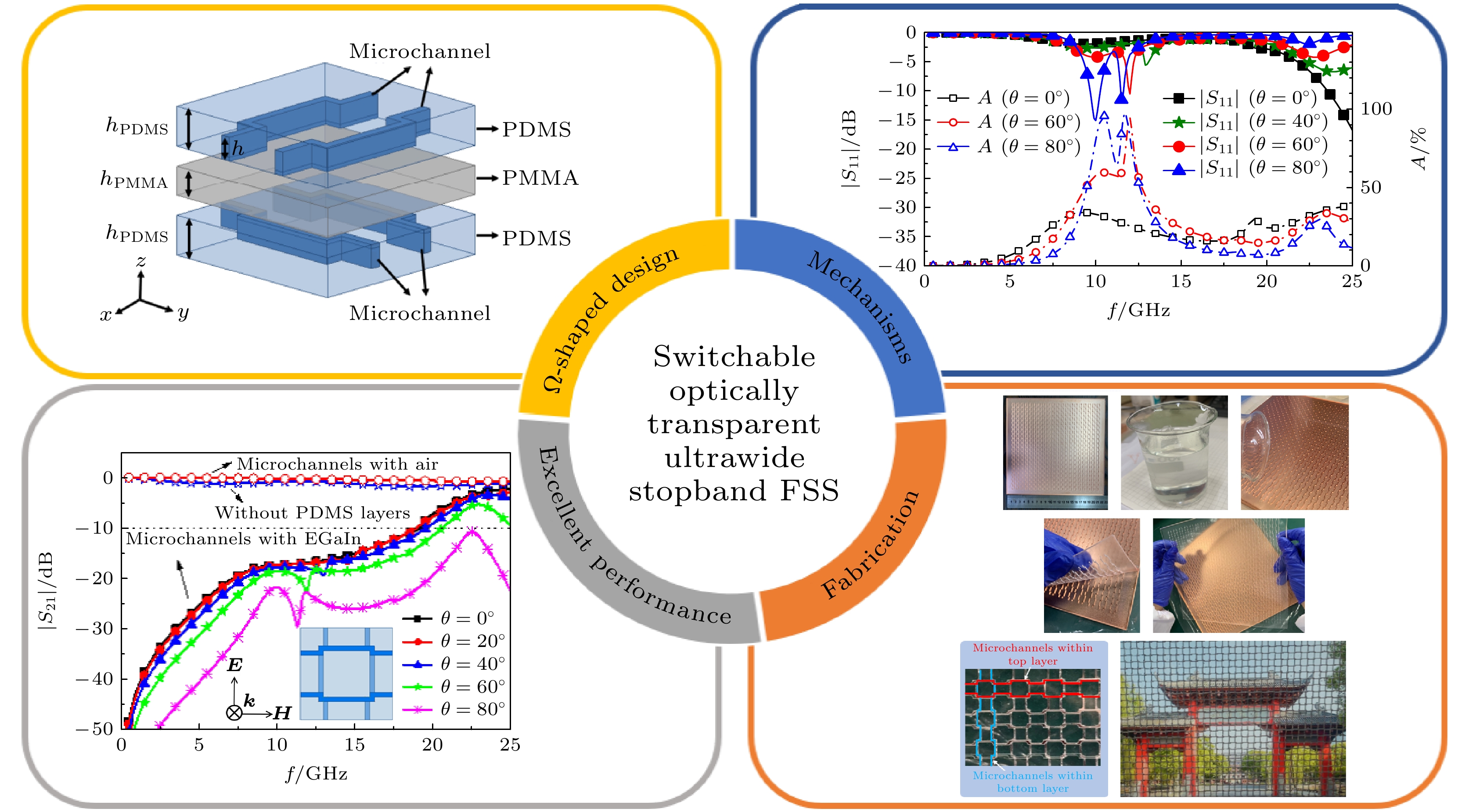

 下载:
下载:
